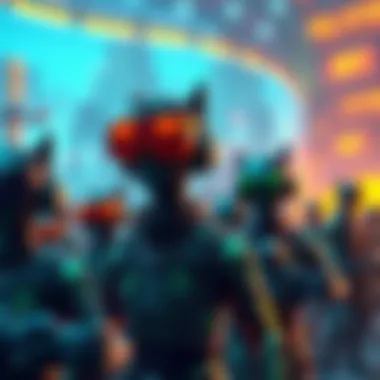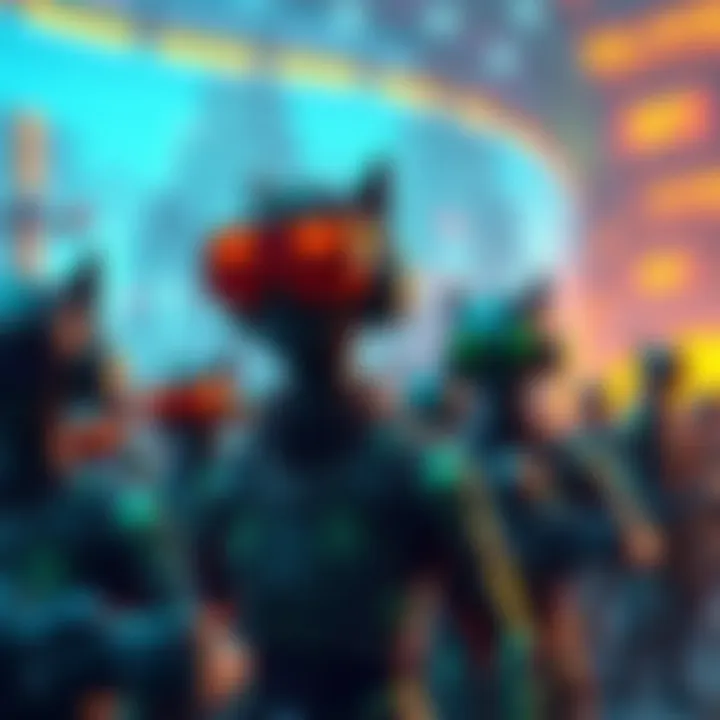Utilizing NFTs: A Comprehensive Guide to Applications


Intro
In recent years, Non-Fungible Tokens (NFTs) have catapulted into the limelight, capturing the imaginations of investors, artists, and technophiles alike. Unlike cryptocurrencies such as Bitcoin or Ethereum, where each unit is identical and easily interchangeable, NFTs represent unique digital assets. This distinctiveness is what sets them apart and allows for innovative applications across various fields.
NFTs are revolutionizing how we think about ownership and value in the digital realm. From art to gaming and even real estate, their influence is growing, and keeping pace with these trends is vital for anyone looking to navigate this dynamic landscape. Rather than getting lost in technical jargon, this guide aims to demystify NFTs and offer practical insights into their utilization for both creators and buyers.
The exploration begins with the examination of current market trends, providing a rich context for understanding how NFTs are being received across different sectors. We will also explore investment strategies tailored to navigating this new digital frontier, equipping readers with valuable tools for making informed decisions. Finally, we will address the challenges and potentials that lie ahead in the ever-evolving world of NFTs.
Let’s dive into the current state of the market, where both exciting opportunities and daunting challenges await.
Understanding NFTs
In today's ever-evolving landscape of digital assets, grasping the concept of Non-Fungible Tokens (NFTs) serves as a crucial first step. These tokens are not just a passing trend; they're a reflection of ownership and value in the digital realm. Understanding NFTs is essential for anyone looking to navigate the waves of investment and creativity, as it highlights the unique attributes that distinguish these tokens from others.
The significance of this topic lies in the myriad applications that NFTs can offer, whether you are an artist, a collector, or a curious explorer of the blockchain world. They represent a shift in how we perceive ownership, moving beyond physical assets into the digital sphere. With that in mind, let’s take a closer look at the definition of Non-Fungible Tokens and how they contrast with traditional cryptocurrencies.
Definition of Non-Fungible Tokens
Non-Fungible Tokens are unique digital assets verified through blockchain technology, representing ownership of a specific item or piece of content. Unlike cryptocurrencies, such as Bitcoin or Ethereum, which are fungible and can be exchanged for one another at equal value, NFTs are distinct and cannot be swapped on a one-to-one basis.
In essence, each NFT has its own unique metadata and characteristics that make it irreplaceable. Think of it like a rare trading card. You might have a Michael Jordan rookie card that is one-of-a-kind; it holds its own value apart from any other card. The same concept applies to NFTs, where each token can signify anything from digital art, music, to virtual real estate.
The uniqueness of NFTs creates specificity in ownership, leading to the emergence of an entirely new economy focused on digital goods. The popularity of platforms like OpenSea and Rarible showcases how artists and creators can capitalize on this distinctiveness, making their work available to a global audience.
How NFTs Differ from Cryptocurrencies
When examining NFTs and cryptocurrencies, it’s important to note the fundamental differences between the two. While both are built upon blockchain technology, their purposes and functionalities diverge significantly.
- Fungibility: As mentioned earlier, cryptocurrencies are fungible; they can be exchanged for one another. For instance, two Bitcoins are equal in value and can be traded seamlessly.
- Uniqueness: In contrast, NFTs are non-fungible. Each token carries its own unique features and values. This makes them particularly useful for representing ownership of specific items.
- Market Dynamics: The market for cryptocurrencies is dominated by speculation and trading behavior, where exchanges are frequent and values can fluctuate wildly from day to day. NFTs, however, often have their value based on rarity, artistic merit, or the emotional value attached to them.
"NFTs aren’t just novelties; they’re reshaping how we think about ownership, proving that digital goods can hold just as much value as physical ones."
The Technology Behind NFTs
The backbone of Non-Fungible Tokens (NFTs) lies in a blend of various technological elements. Understanding this technology is not just nerdy trivia; it offers essential insights into how NFTs function and why they are rapidly gaining traction across several industries. This section will unravel the key components, benefits, and considerations tied to the technology that makes NFTs possible.
Blockchain Technology and NFTs
At the heart of NFTs is blockchain technology, a decentralized ledger that records transactions in a way that is both secure and transparent. This technology underpins the very essence of NFTs. Unlike traditional assets, which can be altered or counterfeited, the immutability of blockchain ensures that ownership of an NFT is permanent and verifiable.
Consider this: when you purchase an NFT, you’re not just buying digital art; you’re acquiring a unique entry on the blockchain that certifies your ownership. This eliminates the risk of duplicates. For example, think of a rare baseball card. If you own the original, you have something special. Blockchain provides a similar guarantee, removing ambiguity over ownership.
Some key points about blockchain technology’s role in NFTs include:
- Transparency: Every transaction is public and can be reviewed by anyone.
- Security: Cryptographic principles protect user identities and transaction data.
- Decentralization: No central authority has control, diminishing interference from third-parties.
In a world where digital ownership is becoming crucial, understanding the implications of blockchain technology on NFTs is imperative for investors and collectors alike.
Smart Contracts Explained
A significant aspect of NFTs that sets them apart are smart contracts. These are self-executing contracts with the terms of the agreement directly written into lines of code. They are deployed on the blockchain and autoplay actions based on specific conditions being met. For NFTs, this means that when an NFT is sold, the smart contract ensures that the transaction happens smoothly and securely.
Smart contracts handle everything from the sale price to royalties for the original creator every time the NFT is sold in the future. This is a game-changer for artists and musicians who have struggled to maintain rights over their work in traditional markets. It provides a new revenue stream without the need for intermediaries.
Here are some important features of smart contracts related to NFTs:
- Autonomous Operations: Transactions occur without human intervention.
- Trustless Environments: Buyers and sellers don’t need to know each other to execute benefits.
- Transparent Conditions: All conditions and stipulations are visible on the blockchain.
"Smart contracts allow for a new era of digital interactions where trust is built into the technology itself rather than relying on individuals or institutions."


As we look ahead, it’s essential for investors to grasp how these smart contracts operate. They hold the key to not only owning NFTs but also reaping their long-term benefits. Understanding the intricacies of this technology may provide a more robust framework for making grounded investment decisions in the NFT landscape.
Understanding the technology behind NFTs is crucial if one is to navigate this burgeoning field successfully. With blockchain technology facilitating secure transactions and smart contracts ensuring the rightful distribution of sales, the foundations are laid for a future where digital ownership is as significant as physical assets. As we delve deeper into the applications of NFTs, it becomes increasingly clear just how intertwined these technologies are with various industries.
Applications of NFTs
The advent of Non-Fungible Tokens has ushered in a transformative wave across multiple sectors, showcasing a myriad of applications that go well beyond mere digital art. This section uncovers the implications and significance of NFTs in distinct domains, shining a light on how these unique digital assets are reshaping our understanding of ownership, value, and engagement.
NFTs in Art and Collectibles
The realm of art has seen a seismic shift with the emergence of NFTs. Traditional artists, as well as digital creators, can now tokenize their work, ensuring authenticity and provenance in a way that was previously unattainable. Collectors who once faced challenges in verifying the legitimacy of works are finding solace in blockchain technology, as it records each transaction transparently. This provides a robust digital certificate of ownership which is a game-changer in art marketing and investment.
"The beauty of NFTs lies not just in the art but in the ownership experience they provide."
Additionally, platforms such as OpenSea and Rarible have made buying and selling such tokens accessible to a wider audience. Artists now have the potential to earn royalties on secondary sales through smart contracts, empowering them and ensuring continued income after the initial sale.
Benefits include:
- Enhanced Verification: Instant proof of ownership eliminates counterfeit risks.
- Increased Accessibility: Artists can reach a global audience without intermediary galleries.
- Royalties on Resales: Continuous earnings from secondary markets.
Gaming and Virtual Experiences
Gaming has taken a leap into the NFT universe as well. Gamers are no longer mere players; they can own, trade, and sell their in-game assets as NFTs. Wearable items, unique skins, or even entire characters can be tokenized, establishing real-world value within virtual realms. This ownership can vastly improve player engagement, as players invest more in games when they know their assets hold value.
Moreover, some gaming environments—like Decentraland—allow users to create virtual experiences, from concerts to art galleries within their digital lands. Here, NFTs serve not just as collectibles but also as critical tools for creating businesses within these virtual spaces.
NFTs in Real Estate
The property market is also feeling the pinch of innovation from NFTs. By leveraging tokenization, real estate transactions become more efficient, streamlining processes involved in property buying and selling. A physical asset can be converted into NFT, representing ownership of a fraction of the asset. This not only reduces paperwork but also opens investment opportunities for a larger pool of investors.
For instance, a luxury condo can be tokenized, allowing multiple investors to own shares of it through purchased NFTs. This democratizes real estate investing, making it more accessible to the average investor who may not have the capital to buy entire properties outright.
Digital Identity and Verification
Digital identity verification is gaining traction in our increasingly online world. NFTs can offer a secure, immutable way to establish identity, linking an individual to specific credentials or achievements without risking falsification. This is not just revolutionary for personal verification, but it also has the potential to transform online services such as banking, healthcare, and even voting.
By creating a unique digital identity NFT, individuals can maintain control over their data and share it selectively, addressing growing concerns around privacy and data ownership. This application is particularly vital as society moves toward decentralized systems that prioritize user control over traditional data storage methods.
The essence of NFTs lies in their versatility and capacity to redefine long-held norms, whether it’s in the art world, gaming, real estate, or identity management. As innovators continue to explore and develop these applications, the vast potential of NFTs becomes ever more apparent.
Buying and Selling NFTs
In the fast-paced world of Non-Fungible Tokens, understanding the landscape of buying and selling NFTs is crucial for anyone looking to dive in. It’s not just about participating in a trend; it’s about tapping into a whole new dimension of digital ownership and investment. With platforms catering to various niches and audiences, knowing how to navigate this landscape effectively can yield significant benefits, whether you’re an investor, creator, or enthusiast. The right approach to buying or selling NFTs can significantly influence the value and success of your digital assets.
Choosing a Marketplace
When it comes to acquiring or trading NFTs, your first step lies in selecting the right marketplace. There are myriad platforms available, each with its unique features, fees, and communities. Some popular places to consider are OpenSea, Rarible, and Foundation. Each platform caters to different needs:
- OpenSea: Considered the largest NFT marketplace, it offers a wide range of digital assets, from art to virtual real estate. It’s user-friendly, even for newcomers.
- Rarible: Here, you can also mint and sell your own NFTs, making it an attractive option for creators. Additionally, it operates on a community-driven governance model, which gives users a stake in the platform’s future.
- Foundation: This platform emphasizes digital art and is invite-only, fostering a curated collection of works. It attracts artists seeking to establish themselves in the NFT space.
Choosing the right marketplace doesn’t just affect the buying process; it can also impact potential returns when selling. Some platforms may cater more to niche audiences, leading to higher demand for specific types of NFTs.
Setting Up a Digital Wallet
Before diving into transactions, securing a digital wallet is paramount. A digital wallet is where your NFTs will be stored; it functions much like a bank account but tailored for cryptocurrency and digital assets. Popular options include MetaMask and Coinbase Wallet, which allow users to interact with various marketplaces seamlessly.
To set up your wallet, follow these simple steps:
- Download a wallet app: Choose a reputable wallet, preferably one that aligns with the marketplace you intend to use.
- Create an account: Follow the prompts. You’ll likely need to set a password and secure certain recovery phrases.
- Add funds: Ensure you have some cryptocurrency (like Ethereum) in your wallet. Most NFTs are purchased using Ethereum, so you’ll need to convert your fiat money into crypto on platforms like Coinbase or Binance.
- Connect to a marketplace: With your wallet set up, you’ll connect it to your chosen NFT marketplace, allowing for easy transfers and transactions.


With the right wallet, not only do you safeguard your digital assets, but you also position yourself to participate smoothly in the NFT market.
Bidding and Pricing Strategies
Navigating the bidding and pricing landscape in NFT transactions isn’t just a simple matter of throwing money at the highest-priced art or collectibles. It often requires strategy and an understanding of market trends. Here are key strategies and considerations:
- Research the Market: Before making purchases or placing bids, take time to analyze recent sales of similar NFTs. This allows you to gauge what buyers are currently valuing.
- Set a Budget: Just because an NFT is trending doesn’t mean you should overspend. Establish a budget and avoid emotional buying—stick to what makes sense financially.
- Consider Auction Dynamics: Know that many NFTs are sold in auction formats. Keep an eye on how bidding progresses—sometimes, bidding wars can inflate prices unpredictably.
- Explore Buy It Now Options: Some listings allow you to purchase instantly without the need for an auction. Analyze these options as they might offer fair deals without the risk of missing out if auctions take a turn.
- Understand Ownership History: The previous owners and how often an NFT has been resold can affect its current worth. Assets that have changed hands many times tend to carry more perceived value.
Ultimately, auction strategies and pricing considerations can shape your experience in buying and selling NFTs, ensuring you approach each transaction with wisdom and clarity.
"Understanding the marketplace specifics and properly managing your assets often determines your success in the NFT landscape."
In summation, buying and selling NFTs is not merely a transactional exercise; it encompasses strategic foresight, market comprehension, and a thoughtful approach to ownership.
For more insights on NFT marketplaces, you may explore Wikipedia or engage with community discussions on platforms like Reddit to get real-time updates and experiences from other users.
Creating Your Own NFTs
In the vast landscape of digital assets, creating your own Non-Fungible Tokens (NFTs) stands out as an avenue for artists, developers, and entrepreneurs alike. It enables creators to express their individuality and monetize their work while influencing the digital economy. This section emphasizes the importance of NFT creation, exploring fundamental aspects, benefits, and crucial considerations.
Conceptualizing Your NFT Project
Before diving headfirst into minting an NFT, it’s vital to define the core concept of your project. Get your creative juices flowing and ask yourself some key questions:
- What type of digital asset do you want to represent? This could be artwork, music, video, or even virtual real estate. Knowing your medium helps in shaping your approach.
- Who is your target audience? Understanding your audience gives you insight into what they value and how to engage with them.
- What narrative or theme will your NFTs convey? It can be based on a personal story or a broader social commentary, making your project relatable.
Creating a strong conceptual foundation not only enhances the NFT’s appeal but also provides a story that buyers can connect with. This connection can greatly influence their willingness to invest.
Minting Process Overview
The minting process refers to the conversion of your digital asset into an NFT that lives on a blockchain. While it may seem daunting, breaking it down into manageable steps can ease the path:
- Choose a Blockchain: Decide on which blockchain to mint your NFTs—Ethereum is the widely accepted option, but others like Flow or Tezos offer alternatives worth considering.
- Select a Marketplace: Platforms like OpenSea or Rarible are popular choices for minting NFTs. Each has its own set of features, so consider what suits your needs best.
- Create a Digital Wallet: To hold your NFTs, you need a cryptocurrency wallet. Make sure it supports the blockchain you've chosen.
- Upload Your Digital Asset: Once your wallet is set, upload your asset to your chosen platform. You’ll typically provide a title and description as well.
- Set Pricing: Choose a selling price or auction model, depending on your strategy.
The minting phase is where your creativity becomes a tradable asset, bridging the gap between art and commerce.
Marketing Your NFTs Effectively
Creating an NFT is only half the battle; getting it noticed is the other. Marketing is instrumental in ensuring your NFTs reach potential buyers. Here are several strategies to consider:
- Leverage Social Media: Platforms like Twitter and Instagram are hotspots for NFT communities. Regular engagement can help cultivate interest in your projects.
- Collaborations: Teaming up with established NFT creators can broaden your reach and lend credibility to your work.
- Content Marketing: Share stories, tutorials, or behind-the-scenes processes on platforms such as Medium or personal blogs. It’s about building a narrative around your NFTs that speaks to potential buyers.
- Email Marketing: Maintain a mailing list to update your audience on upcoming drops, giveaways, or blog posts related to your NFTs. This creates a sense of exclusivity and keeps people engaged.
While the NFT market can be saturated, standing out through effective marketing can help you secure a dedicated audience.
The world of NFTs thrives on innovation, creativity, and community engagement. Each creator has a unique story to tell, and it’s the narrative that often drives interest and value.
Navigating the process of creating your own NFTs entails more than just technical know-how; it's an artful blend of personality, strategy, and understanding your audience. From conceptualization to marketing, each step should reflect your vision while adapting to the evolving digital landscape.
Legal and Ethical Considerations
When diving into the world of Non-Fungible Tokens (NFTs), it becomes evident that legal and ethical considerations play a fundamental role in shaping this rapidly evolving landscape. As digital assets grow in popularity, understanding the implications surrounding NFTs is paramount for creators, investors, and enthusiasts alike. These considerations not only influence the operational framework of NFTs but also the perception of their value and legitimacy in the marketplace. Therefore, delving into copyright, consumer protection, and sustainability reveals deeper truths about how NFTs impact society and economic realities.
Understanding Copyright Implications
One of the first and most crucial elements to consider in the NFT sphere is copyright. By nature, NFTs can represent ownership of digital items, but ownership does not equate to ownership of the intellectual property itself. For instance, if an artist creates a digital painting and mints it as an NFT, the buyer of the NFT usually does not gain the copyright to reproduce or sell the artwork without the artist’s permission. This distinction is vital for both creators and collectors.
- Rights and Usage: It is essential to clearly outline what rights the NFT owner receives. Is it merely the right to display the art, or can they also commercialize it? Without clear understanding and enforcement, disputes over rights can escalate.
- Infringement Risks: Artists must ensure that their work doesn’t infringe upon the rights of others, as legal battles over ownership can be extraordinarily costly and damaging.
- Traditional Copyright Laws: Existing copyright laws are being tested and manipulated in the world of NFTs, and it remains vital to stay updated on this front, as legal precedents are still being established. Institutions like WIPO are actively engaging with these new legal territories.
Consumer Protection Issues


Consumer protection is another tightly-knit aspect to grasp when navigating NFTs. Just as in any marketplace, buyers deserve transparency and security. However, the nascent nature of NFTs has left many buyers in murky waters.
- Transparency: Proper information regarding the origin and history of NFTs is crucial. Buyers should ensure they know if they are purchasing original work or a copy. Not being aware can lead to regrets and significant losses.
- Scams and Frauds: The NFT space, much like the Wild West, has its share of fraud. Phishing schemes and fake marketplaces can ensnare even the most cautious. Thus, vigilance is paramount. Using established platforms and verifying creators is advisable.
- Regulatory Uncertainty: Many regions still lack well-defined regulations on NFTs. This uncertainty can leave consumers vulnerable, warranting guidelines similar to traditional consumer protection laws as digital goods continue to rise.
“Consumers deserve the same level of protection in the digital world as they do in brick-and-mortar stores.”
Sustainability and NFTs
One cannot disregard the environmental impacts when discussing NFTs. The process of minting and transacting NFTs often involves energy-intensive blockchain transactions, particularly those on proof-of-work networks like Ethereum. Therefore, sustainability issues swirl around NFTs and their place amid growing climate concern.
- Energy Consumption: The high energy requirement for validating transactions on these blockchains has drawn criticism. Many argue that it contributes to global carbon emissions, hence raising questions of moral responsibility among creators and users of NFTs.
- Alternative Solutions: Several newer blockchain technologies, such as proof-of-stake networks, have arisen to mitigate these concerns by consuming less energy. Understanding which platforms prioritize sustainability can help shape ethical practices within the NFT marketplace.
- Awareness and Responsibility: Creators may find value in promoting sustainable NFTs by actively choosing eco-friendly platforms and practices. This can bolster their brand reputation and cater to a more conscience-driven audience.
As NFTs permeate numerous industries and facets of culture, addressing these legal and ethical considerations is undeniably imperative. Their impact extends beyond mere transactions, influencing creative rights and shaping future digital economies. Ensuring clarity in copyright, safeguarding consumers, and advocating for sustainability builds not only a trustworthy NFT ecosystem but also one aligned with broader societal values.
Challenges in the NFT Landscape
The rise of Non-Fungible Tokens (NFTs) has created a buzz in the digital realm, attracting investors, artists, and innovators alike. However, this burgeoning landscape is not without its hurdles. Understanding these challenges is crucial for anyone looking to navigate the NFT space. Keeping an eye on the obstacles may offer valuable insights into making informed decisions, whether you're buying, selling, or creating NFTs. Let's break down the primary challenges within this domain.
Market Volatility
Market volatility stands as a significant concern for NFT investors. Prices can swing dramatically within short time frames, often leading to uncertainty and unpredictability. For instance, one could witness an NFT selling for thousands of dollars one day, only to see its value plummet to a fraction the next.
- Supply and Demand Factors: Just like any commodity, NFTs are subject to the laws of supply and demand. Popular collections can experience explosive growth, while lesser-known projects might struggle to find traction.
- Speculative Nature: Investment in NFTs is often speculative. Many buyers treat them like a gamble, driven by hype and trends. This speculative behavior can inflate prices beyond their intrinsic value.
- Limited Historical Data: With the NFT market still in its infancy, analyzing long-term trends becomes delicate. Without ample historical data, predicting future movements remains a challenge.
"The NFT market can feel like riding a roller coaster. One day you're on top of the world, the next, you might be staring at a significant loss."
Mitigating the risks associated with market volatility involves thorough research and an understanding of market sentiment. Investors must adopt a disciplined approach, setting clear budget limits to avoid rash decisions.
Fraud and Scams
The NFT space has also become a breeding ground for fraudulent activities, adding to its complexity. Many newcomers to the digital asset world may not be aware of the pitfalls lurking around.
- Counterfeit NFTs: Unscrupulous individuals have been known to create fake versions of popular NFTs, luring unsuspecting buyers into making purchases without realizing they've been duped.
- Rug Pulls: In some cases, developers may abandon their projects after gaining initial investor interest, leaving buyers with worthless tokens and no recourse. This practice is known as a "rug pull," and it underscores the importance of vetting projects thoroughly.
- Phishing Scams: Scammers often employ phishing tactics, crafting emails or websites that seem legitimate to lure victims into providing sensitive information. Once obtained, access to digital wallets can be exploited, leading to devastating losses.
A good way to protect oneself is through comprehensive research. Look into the project’s team, read reviews, and engage with the community. When engaging in financial transactions, confirming the authenticity of the NFT and the marketplace can save an investor from unwanted surprises.
As the NFT landscape continues to evolve, individuals must remain informed about these challenges. Whether contemplating investment or development, awareness of market volatility and potential for fraud is essential to thrive in this dynamic field.
The Future of NFTs
As we stand at the crossroads of innovation and digital ownership, the future of Non-Fungible Tokens (NFTs) appears both promising and complex. Their outgrowth from niche markets into various sectors highlights their significance. These tokens are not just digital collectibles; they represent unique ownership of assets, fundamentally changing how we perceive property in a digital age. Understanding the trajectory of NFTs is crucial for enthusiasts and investors alike, providing insights into potential opportunities and pitfalls.
Integration into Different Industries
NFTs are already carving out spaces in industries beyond the realms of art and gaming. They hold the potential to disrupt numerous sectors, bringing a fresh perspective on how assets are perceived and traded. For instance:
- Fashion: Designers can launch limited digital fashion items that can be worn in virtual environments, thus creating a blend between physical and digital wardrobes. Brands like Gucci are experimenting with digital fashion, attracting tech-savvy consumers.
- Music and Entertainment: Musicians are exploring NFTs for album releases, providing fans with exclusive content, front-row tickets, or even royalties. This provides a direct revenue stream that bypasses traditional music industry intermediaries.
- Real Estate: Fractional ownership of properties through NFTs can revolutionize how real estate is bought and sold. By tokenizing real estate assets, buyers can invest in shares of properties, thus broadening access to real estate investments.
The integration of NFTs in various industries could lead to a more efficient marketplace and create new economic models that benefit both creators and consumers.
Potential Regulatory Developments
As with any evolving technology, regulatory frameworks are necessary to ensure that NFTs function smoothly within the legal landscape. Various governments are recognizing the need for oversight, and several key areas warrant attention:
- Taxation: The way NFTs are taxed varies greatly across jurisdictions, creating confusion for traders and investors. Clarity around tax obligations could enhance compliance and foster a more stable market.
- Consumer Protection: With the rise of NFTs, there's an increasing need for regulations that protect buyers from fraud and scams. Measures can be enforced to ensure authenticity and ownership rights of digital assets.
- Intellectual Property: The intersection of NFTs and copyright law is complex. Proper frameworks ensuring creators’ rights while balancing buyers' accessibility to digital art will be crucial for sustainable growth.
"If laws aren't in place, the coins could just be shiny rocks, devoid of legitimacy and trust."
The proactive involvement of regulatory bodies can shape the longevity and trustworthiness of NFTs in the marketplace.
Technological Innovations Impacting NFTs
As technology evolves, so too do the functionalities and applications of NFTs. The following innovations are set to significantly impact their future:
- Layer-2 Solutions: Technologies aimed at scaling blockchain networks will address current limitations related to speed and cost of transactions. This could enhance the user experience when minting and trading NFTs.
- Interoperability: The ability for NFTs to be utilized across different platforms and ecosystems will expand their usability. This concept of interoperability can increase the reach and utility of NFTs, allowing creators to reach broader audiences.
- Improved User Interfaces: As platforms evolve, user experience will improve, making it easier for non-tech-savvy individuals to engage with NFTs. Educating users through seamless interfaces will foster a wider adoption.
In summary, the landscape of NFTs is set to shift significantly as industries integrate these tokens, regulatory bodies establish their frameworks, and technological innovations enhance functionality. Investors, traders, and analysts must stay on their toes, anticipating changes that may shape the NFT marketplace in unpredictable yet exciting ways.















